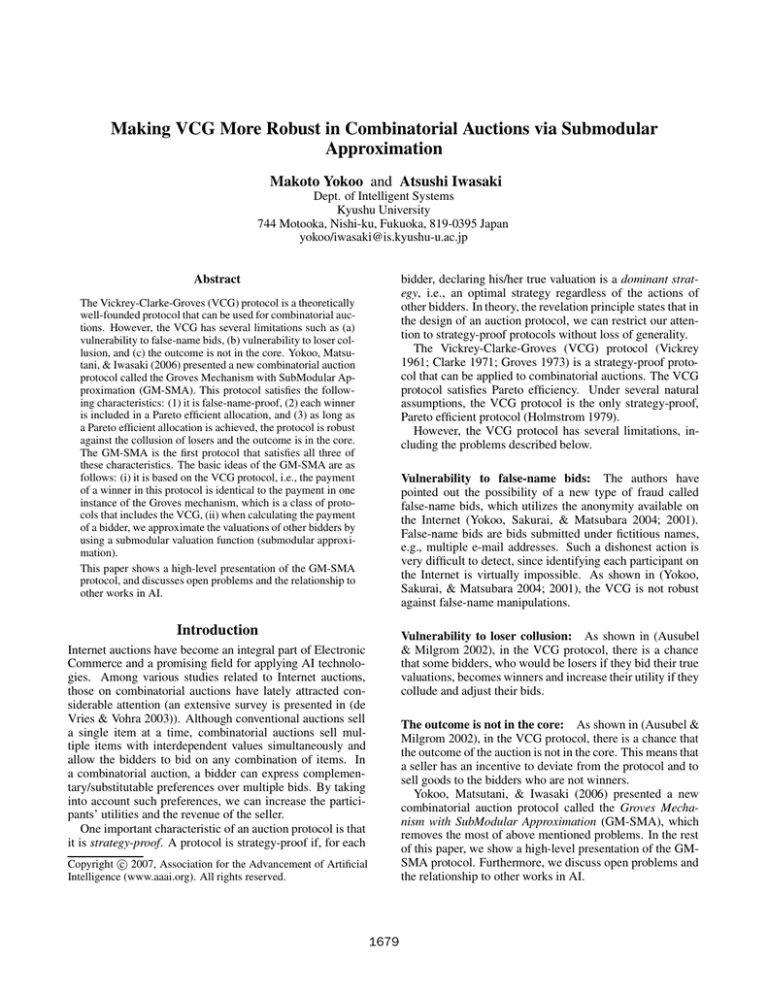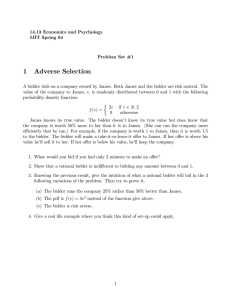Making VCG More Robust in Combinatorial Auctions via Submodular Approximation Makoto Yokoo
advertisement

Making VCG More Robust in Combinatorial Auctions via Submodular
Approximation
Makoto Yokoo and Atsushi Iwasaki
Dept. of Intelligent Systems
Kyushu University
744 Motooka, Nishi-ku, Fukuoka, 819-0395 Japan
yokoo/iwasaki@is.kyushu-u.ac.jp
Abstract
bidder, declaring his/her true valuation is a dominant strategy, i.e., an optimal strategy regardless of the actions of
other bidders. In theory, the revelation principle states that in
the design of an auction protocol, we can restrict our attention to strategy-proof protocols without loss of generality.
The Vickrey-Clarke-Groves (VCG) protocol (Vickrey
1961; Clarke 1971; Groves 1973) is a strategy-proof protocol that can be applied to combinatorial auctions. The VCG
protocol satisfies Pareto efficiency. Under several natural
assumptions, the VCG protocol is the only strategy-proof,
Pareto efficient protocol (Holmstrom 1979).
However, the VCG protocol has several limitations, including the problems described below.
The Vickrey-Clarke-Groves (VCG) protocol is a theoretically
well-founded protocol that can be used for combinatorial auctions. However, the VCG has several limitations such as (a)
vulnerability to false-name bids, (b) vulnerability to loser collusion, and (c) the outcome is not in the core. Yokoo, Matsutani, & Iwasaki (2006) presented a new combinatorial auction
protocol called the Groves Mechanism with SubModular Approximation (GM-SMA). This protocol satisfies the following characteristics: (1) it is false-name-proof, (2) each winner
is included in a Pareto efficient allocation, and (3) as long as
a Pareto efficient allocation is achieved, the protocol is robust
against the collusion of losers and the outcome is in the core.
The GM-SMA is the first protocol that satisfies all three of
these characteristics. The basic ideas of the GM-SMA are as
follows: (i) it is based on the VCG protocol, i.e., the payment
of a winner in this protocol is identical to the payment in one
instance of the Groves mechanism, which is a class of protocols that includes the VCG, (ii) when calculating the payment
of a bidder, we approximate the valuations of other bidders by
using a submodular valuation function (submodular approximation).
This paper shows a high-level presentation of the GM-SMA
protocol, and discusses open problems and the relationship to
other works in AI.
Vulnerability to false-name bids: The authors have
pointed out the possibility of a new type of fraud called
false-name bids, which utilizes the anonymity available on
the Internet (Yokoo, Sakurai, & Matsubara 2004; 2001).
False-name bids are bids submitted under fictitious names,
e.g., multiple e-mail addresses. Such a dishonest action is
very difficult to detect, since identifying each participant on
the Internet is virtually impossible. As shown in (Yokoo,
Sakurai, & Matsubara 2004; 2001), the VCG is not robust
against false-name manipulations.
Introduction
Vulnerability to loser collusion: As shown in (Ausubel
& Milgrom 2002), in the VCG protocol, there is a chance
that some bidders, who would be losers if they bid their true
valuations, becomes winners and increase their utility if they
collude and adjust their bids.
Internet auctions have become an integral part of Electronic
Commerce and a promising field for applying AI technologies. Among various studies related to Internet auctions,
those on combinatorial auctions have lately attracted considerable attention (an extensive survey is presented in (de
Vries & Vohra 2003)). Although conventional auctions sell
a single item at a time, combinatorial auctions sell multiple items with interdependent values simultaneously and
allow the bidders to bid on any combination of items. In
a combinatorial auction, a bidder can express complementary/substitutable preferences over multiple bids. By taking
into account such preferences, we can increase the participants’ utilities and the revenue of the seller.
One important characteristic of an auction protocol is that
it is strategy-proof. A protocol is strategy-proof if, for each
The outcome is not in the core: As shown in (Ausubel &
Milgrom 2002), in the VCG protocol, there is a chance that
the outcome of the auction is not in the core. This means that
a seller has an incentive to deviate from the protocol and to
sell goods to the bidders who are not winners.
Yokoo, Matsutani, & Iwasaki (2006) presented a new
combinatorial auction protocol called the Groves Mechanism with SubModular Approximation (GM-SMA), which
removes the most of above mentioned problems. In the rest
of this paper, we show a high-level presentation of the GMSMA protocol. Furthermore, we discuss open problems and
the relationship to other works in AI.
c 2007, Association for the Advancement of Artificial
Copyright Intelligence (www.aaai.org). All rights reserved.
1679
Model
Assume there are a set of bidders N = {1, 2, . . . , n} and a
set of goods M = {1, 2, . . . , m}. Each bidder i has his/her
preferences over B ⊆ M . Formally, we model this by supposing that bidder i privately observes a parameter, or signal,
θi , which determines his/her preferences. We refer to θ i as
the type of bidder i. We assume θ i is drawn from a set Θ.
We also assume a quasi-linear, private value model with no
allocative externality, defined as follows.
Definition 1 utility of a bidder
The utility of bidder i, when i obtains a bundle, i.e., a subset
of goods B ⊆ M and pays p B,i , is represented as v(B, θi )−
pB,i .
V ∗ (B, ΘS ) is defined as maxg i∈S v(Bi , θi ), where θi is
the type of bidder i.
The VCG protocol can be described as follows. For simplicity, we describe the protocol assuming each bidder i declares his/her true type θ i .
1. The auctioneer finds a Pareto efficient allocation. The
auctioneer can choose an arbitrary one if there exist multiple Pareto efficient allocation.
2. When B is allocated to bidder i in that allocation, bidder i
pays the following VCG price p B,i :
pB,i = V ∗ (M, ΘN \{i} ) − V ∗ (M \ B, ΘN \{i} ).
Let us describe how this protocol works.
Example 1 Assume there are two goods 1 and 2, and three
bidders, bidder 1, 2, and 3, whose types are θ 1 , θ2 , and θ3 ,
respectively. The valuation for a bundle v(B, θ i ) is determined as follows.
We assume the valuation v is normalized by v(∅, θ i ) = 0.
Furthermore, we assume free disposal, i.e., v(B , θi ) ≥
v(B, θi ) for all B ⊇ B.
In a traditional definition (Mas-Colell, Whinston, &
Green 1995), an auction protocol is (dominant-strategy) incentive compatible (or strategy-proof ) if declaring the true
type/valuation is a dominant strategy for each bidder, i.e., an
optimal strategy regardless of the actions of other bidders.
In this paper, we use an extended definition of incentive
compatibility so that it can address false-name bid manipulations, i.e., we define that an auction protocol is (dominantstrategy) incentive compatible if declaring the true type by
using a single identifier is a dominant strategy for each bidder. To distinguish between the traditional and extended definitions of incentive compatibility, we refer to the traditional
definition as strategy-proof and to the extended definition as
false-name-proof.
As in the case of strategy-proof protocols, the revelation principle holds for false-name-proof protocols (Yokoo,
Sakurai, & Matsubara 2004). More specifically, if a certain property (e.g., Pareto efficiency) can be achieved using some auction protocol in a dominant-strategy equilibrium, i.e., a combination of dominant strategies of bidders,
the property can also be achieved using a false-name-proof
protocol. Thus, we can restrict our attention to false-nameproof protocols without loss of generality.
We say an auction protocol is Pareto efficient when the
sum of all participants’ utilities (including that of the auctioneer), i.e., the social surplus, is maximized in a dominantstrategy equilibrium. We have proved that there exists
no false-name-proof protocol that satisfies Pareto efficiency
(Yokoo, Sakurai, & Matsubara 2004). Therefore, we need to
sacrifice efficiency to some extent when false-name bids are
possible.
θ1
θ2
θ3
{1}
6
0
0
{2} {1, 2}
0
6
0
8
5
5
The Pareto efficient allocation is allocating good 1 to bidder 1 and good 2 to bidder 3, respectively. The price for
bidder 1 is calculated as 8 − 5 = 3. Similarly, the price for
bidder 3 is calculated as 8 − 6 = 2.
Now, we can see that this outcome is not in the core. Let
us assume another allocation where both goods are sold to
bidder 2 at price 7. Then, both the seller and bidder 2 prefer
this allocation to the outcome of the VCG protocol. Such a
coalition, in this case, the coalition of the seller and bidder 2,
is called a blocking coalition.
Let us consider another situation.
Example 2 Assume there are two goods 1 and 2, and two
bidders, bidder 1 and 2, whose types are θ 1 and θ2 , respectively. The valuation for a bundle v(B, θ i ) is determined as
follows.
θ1
θ2
{1}
4
0
{2} {1, 2}
3
7
0
8
The Pareto efficient allocation is allocating both goods to
bidder 2. The price for bidder 2 is calculated as 7 − 0 = 7.
Now, we can see that the VCG protocol is not false-nameproof. Bidder 1 can split his/her bid using another identifier,
i.e., bidder 3, so that the situation becomes identical to Example 1. Then, bidder 1 can obtain both goods by paying
2 + 3 = 5, which is less than his/her valuation. Thus, bidder 1 can increase his/her utility by using a false-name bid.
Let us consider another situation.
Example 3 Assume there are two goods 1 and 2, and three
bidders, bidder 1, 2, and 3, whose types are θ 1 , θ2 , and θ3 ,
respectively. The valuation for a bundle v(B, θ i ) is determined as follows.
VCG Protocol
Next, we briefly outline the VCG protocol. To simplify the
protocol description, we introduce the following notation.
For a set of goods B and a set of bidders S, where Θ S is
a set of types of bidders in S, we define V ∗ (B, ΘS ) as the
sum of the valuations of S when B is allocated optimally
among S.
To beprecise, for a feasible allocation g = (B 1 , B2 , . . .),
where i∈S Bi ⊆ B and for all i = i , Bi ∩ Bi = ∅,
1680
θ1
θ2
θ3
{1}
4
0
0
From this definition, U ∗ satisfies the following conditions:
{2} {1, 2}
0
4
0
8
3
3
The Pareto efficient allocation is allocating both goods to
bidder 2. The price for bidder 2 is calculated as 7 − 0 = 7.
Now, we can see that the VCG protocol is vulnerable to
the collusion of losers. If bidder 1 and bidder 3 collude and
increase their valuations, they can create a situation identical
to Example 1. Then, bidder 1 obtains good 1 at price 3, and
bidder 3 obtains good 2 at price 2. For each bidder, this price
is less than his/her valuation, thus bidders can increase their
utilities by engaging in collusion.
• For all S ⊆ N, B ⊆ M , U ∗ (B, ΘS ) ≥ V ∗ (B, ΘS )
holds.
• For all S ⊆ N, B ⊆ M , U ∗ (M, ΘN ) ≥ U ∗ (B, ΘS ) +
U ∗ (M \ B, ΘN \S ) holds.
The Groves Mechanism with SubModular Approximation
(GM-SMA) is described as follows.
1. The auctioneer finds a Pareto efficient allocation. The
auctioneer can choose an arbitrary one if there exist multiple Pareto efficient allocation.
2. When B is allocated to bidder i in that allocation, the auctioneer calculates the GM-SMA price p B,i defined as follows:
Groves Mechanism with SubModular
Approximation (GM-SMA)
• When B = ∅, pB,i = 0.
• Otherwise, pB,i = U ∗ (M, ΘN \{i} ) − V ∗ (M \
B, ΘN \{i} ).
Basic Idea
The basic idea behind the GM-SMA protocol can be described as follows. It is well-known that the valuations
of bidders satisfy a property called submodularity, the
above mentioned limitations of the VCG protocol disappear (Ausubel & Milgrom 2002). The valuations of a set
of bidders N is called submodular if the following condition holds: for all S ⊆ N, B , B ⊆ M , V ∗ (B , ΘS ) +
V ∗ (B , ΘS ) ≥ V ∗ (B ∪ B , ΘS ) + V ∗ (B ∩ B , ΘS ).
When B and B are mutually exclusive, this condition
means that the sum of the valuations of having B and B separately is always larger than (or at least equal to) the valuation of having B and B together, i.e., there is no complementarity.
However, the submodularity condition is not satisfied in
general. As a matter of fact, the main motivation of using
a combinatorial auction is the existence of complementary
goods.
The basic idea of the GM-SMA protocol is, if the valuations of bidders are not submodular, we approximate the
valuations as a submodular function and use that function to
calculate the payments in the VCG. As a result, the protocol
has a similar property to the VCG when the valuations are
submodular.
If v(B, θi ) ≥ pB,i , then B is allocated to bidder i at price
pB,i . If v(B, θi ) < pB,i , B is not allocated to any bidder.
Please note that we use U ∗ only for the first term. This protocol is quite similar to the Groves mechanism (Groves 1973),
since the payment of a winner in this protocol is identical
to the payment in one instance of the Groves mechanism.
However, it is not an instance of the Groves mechanism because it does not guarantee to achieve a Pareto efficient allocation. This protocol can be considered as a modification of
the Groves mechanism, in which a winner has an option not
to obtain the goods if the payment becomes too high.
Examples
Here, we describe how the GM-SMA works in the situation of Example 1. In this example, we use v ({1}, θ2 ) =
v ({2}, θ2 ) = 8/2 = 4, and we use v (·, ·) = v(·, ·) for
other bundles and bidders. By choosing v in this way, U ∗
satisfies the submodular condition.
The Pareto efficient allocation is allocating good 1 to bidder 1 and good 2 to bidder 3, respectively. The price for bidder 1 is calculated as (4+5)−5 = 4, where 4 corresponds to
v ({1}, θ2 ) and 5 corresponds to v ({2}, θ3 ). Similarly, the
price for bidder 3 is calculated as (4 + 6) − 6 = 4, where 4
corresponds to v ({2}, θ2 ) and 6 corresponds to v ({1}, θ1 ).
This outcome is in the core. Since the revenue of the seller
is 8, the seller does not have an incentive to deviate from the
protocol with bidder 2 (who is willing to pay at most 8).
Next, we describe how the protocol works in the situation
of Example 2. Here, v is defined in a similar way to the previous example. The Pareto efficient allocation is allocating
both goods to bidder 2. The price for bidder 2 is calculated
as 7 − 0 = 7.
In this case, even if bidder 1 uses a false-name and creates
a situation identical to Example 1, his/her utility cannot be
positive since bidder 1 must pay 4 + 4 = 8 in that situation.
Finally, we describe how the protocol works in the situation of Example 3. Here, v is defined in a similar way to
Protocol Description
To describe the GM-SMA protocol, we first define a concept
called submodular approximation.
Definition 2 submodular approximation U ∗
The function U ∗ defined below is called a submodular approximation of V ∗ .
where
For a feasible allocation g = (B 1 , B2 , . . .),
∗
= ∅, U (B, ΘS )
B
⊆
B
and
for
all
i
=
i
,
B
∩
B
i
i
i
i∈S
is defined as maxg i∈S v (Bi , θi ). v is a function that
satisfies v (B, θi ) ≥ v(B, θi ) for all i, B.
Furthermore, we assume v is chosen so that U ∗ becomes submodular, i.e., for all S ⊆ N, B , B ⊆ M ,
U ∗ (B , ΘS )+ U ∗ (B , ΘS ) ≥ U ∗ (B ∪B , ΘS )+ U ∗ (B ∩
B , ΘS ) holds.
1681
the previous example. The Pareto efficient allocation is allocating both goods to bidder 2. The price for bidder 2 is
calculated as 7 − 0 = 7.
In this case, even if bidder 1 and bidder 3 collude and create a situation identical to Example 1, their utilities cannot
be positive since each must pay 4 in that situation.
and powerful method in mechanism design. It has been considered as a normative protocol, which might be too complicated to be used in practice, but it is theoretically wellfounded. However, as discussed in this paper, the VCG has
several limitations. Besides the issues discussed in this paper, many researchers pointed out other limitations of the
VCG. For example, Karlin, Kempe, & Tamir (2005) show
that the payment can be very high when the VCG is applied
to procurement auctions.
Characteristics of GM-SMA
The GM-SMA satisfies the following characteristics.
References
(1) The GM-SMA is false-name-proof.
Ausubel, L. M., and Milgrom, P. R. 2002. Ascending auctions with package bidding. Frontiers of Theoretical Economics 1(1).
Clarke, E. H. 1971. Multipart pricing of public goods.
Public Choice 2:19–33.
de Vries, S., and Vohra, R. V. 2003. Combinatorial auctions: A survey. INFORMS Journal on Computing 15.
Fujishima, Y.; Leyton-Brown, K.; and Shoham, Y. 1999.
Taming the computation complexity of combinatorial auctions: Optimal and approximate approaches. In Proceedings of the Sixteenth International Joint Conference on Artificial Intelligence (IJCAI-99), 548–553.
Groves, T. 1973. Incentives in teams. Econometrica
41:617–631.
Holmstrom, B. 1979. Groves’ scheme on restricted domains. Econometrica 47(5):1137–1144.
Karlin, A.; Kempe, D.; and Tamir, T. 2005. Beyond VCG:
Frugality of truthful mechanisms. In Proceedings of 46th
IEEE Symp. on Foundations of Computer Science.
Lehmann, D.; O‘Callaghan, L. I.; and Shoham, Y. 2002.
Truth revelation in approximately efficient combinatorial
auctions. Journal of the ACM 49(5):577–602.
Mas-Colell, A.; Whinston, M. D.; and Green, J. R. 1995.
Microeconomic Theory. Oxford University Press.
Sandholm, T. 1999. An algorithm for optimal winner determination in combinatorial auction. In Proceedings of
the Sixteenth International Joint Conference on Artificial
Intelligence (IJCAI-99), 542–547.
Vickrey, W. 1961. Counter speculation, auctions, and competitive sealed tenders. Journal of Finance 16:8–37.
Yokoo, M.; Matsutani, T.; and Iwasaki, A. 2006. Falsename-proof combinatorial auction protocol: Groves mechanism with submodular approximation. In Proceedings
of the Fifth International joint Conference on Autonomous
Agents and Multiagent Systems (AAMAS-2006).
Yokoo, M.; Sakurai, Y.; and Matsubara, S. 2001. Robust
combinatorial auction protocol against false-name bids.
Artificial Intelligence 130(2):167–181.
Yokoo, M.; Sakurai, Y.; and Matsubara, S. 2004. The
effect of false-name bids in combinatorial auctions: New
fraud in Internet auctions. Games and Economic Behavior
46(1):174–188.
(2) In the GM-SMA, each winner is a bidder who is included in a Pareto efficient allocation 1 .
(3) In the GM-SMA, as long as the allocation is Pareto efficient, the protocol is robust against the collusion of the
losers and the outcome is in the core.
The GM-SMA is the first protocol that satisfies all three of
these characteristics. The VCG is not false-name-proof. In
addition, even without false-name bids, the VCG protocol
does not satisfy characteristic (3).
Furthermore, in existing false-name-proof protocols
(Yokoo, Sakurai, & Matsubara 2001), characteristic (2) is
not satisfied, i.e., a bidder who is not included in any Pareto
efficient allocation becomes a winner quite often. In such a
case, the outcome is not in the core. Also, losers who are in
a Pareto efficient allocation will have a strong incentive to
collude and act as a single bidder.
Discussions
The efficiency and the revenue of the GM-SMA critically
depend on the accuracy of the submodular approximation.
Although several simple methods for submodular approximation is introduced in (Yokoo, Matsutani, & Iwasaki
2006), the accuracy of these methods is not satisfactory. Developing better approximation methods is an open problem.
Another open problem is to develop protocols that can be
applied to similar, but different situations, such as combinatorial procurement auctions.
The winner determination problem in combinatorial auctions has been a popular research topic in AI after pioneering works presented in (Sandholm 1999; Fujishima, LeytonBrown, & Shoham 1999). Solving the winner determination problem is NP-complete. Various heuristic search and
optimization techniques have been introduced for solving
the winner determination problem efficiently. When valuations of bidders are submodular, the winner determination problem becomes polynomial time solvable (Lehmann,
O‘Callaghan, & Shoham 2002). It might be possible to develop a false-name-proof protocol that is computationally
efficient by extending the GM-SMA protocol.
Mechanism design is also a popular research topic in AI
and multi-agent systems. The VCG protocol is a general
1
Note that the converse is not true, i.e., there is a chance that the
GM-SMA could fail to achieve a Pareto efficient allocation. This
is inevitable since the GM-SMA is false-name-proof.
1682



